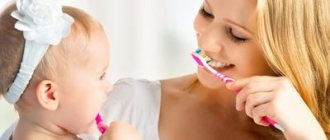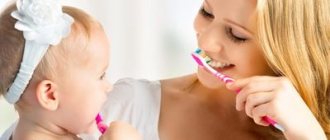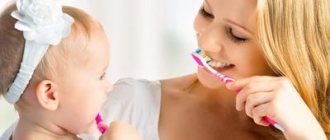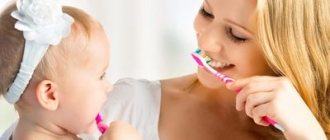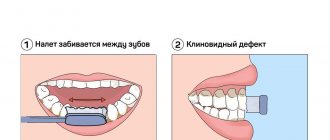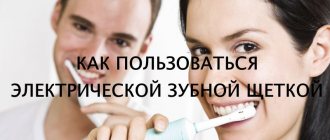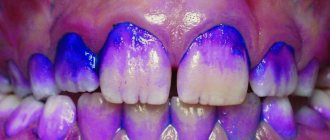The health of the dentition and gum tissue depends on many factors, the key of which is the quality of hygiene procedures.
Regular removal of bacterial plaque and food residues allows you to maintain the natural microflora of the oral cavity and prevents the development and proliferation of pathogenic microorganisms.
At the same time, hygiene procedures must be not only timely, but also correct, and for this it is important to understand exactly how each of the devices intended for cleaning the dental surface should be used.
Using a classic toothbrush
Cleaning with a manual brush should be carried out at least twice a day - in the morning and in the evening (before bedtime). The recommended duration for processing a row using this device is 3-4 minutes.
Scheme for cleaning the upper and lower dentition with a classic toothbrush
Proper cleaning with a classic brush involves the following steps:
- A pea of paste is applied to a brush moistened with water.
- Cleaning begins from the upper jaw. You need to start with the front teeth, gradually moving towards the molars.
- Movements to remove plaque should be sweeping and directed from the gum line to the cutting surface.
- To clean the cutting surface of the teeth, the brush is positioned perpendicular to it, after which circular movements are performed.
- After performing manipulations with the upper row, the same procedure is repeated with the elements of the lower jaw.
- To complete the hygiene procedures, it is necessary to clean the tongue using bristles or the back of the brush head if it is equipped with a rubber grooved surface.
After thoroughly removing plaque with a brush, you can rinse your mouth with a special rinse, which not only helps improve the condition of your teeth and gums, but also ensures fresh breath for a long time.
The video provides a detailed description of using a toothbrush.
What is a wedge-shaped tooth defect and the reasons for its development. Read here all the most interesting things about decorating teeth with rhinestones.
At this address https://dr-zubov.ru/ortopediya/semnye-protezy/kak-osushhestvlyaetsya-remont.html we will tell you whether it is possible to repair a removable denture.
Features of choosing a brush
On the shelves of stores and pharmacies there is an incredible number of brushes in shape and content, which confuses the buyer. To choose the right hygiene device, follow the following recommendations from dentists:
- choose brushes with soft bristles - they are the least traumatic;
- the recommended size of the cleaning head is within 30 cm, and its shape is rounded;
- choose a device made from individual tufts of bristles. This design has an optimal cleaning surface;
- Focus on the shape of the handle - it should provide good shock absorption and comfort during use.
After carrying out hygiene measures, the brush must be washed and left to dry with the bristles facing up. It is recommended to change the device every three to four months.
Electrical devices
The technology of brushing teeth with an electric brush is slightly different from the manipulations carried out with a classic device.
This is due to the absence of the need to exert additional force, since the brush head makes pulsating and rotating movements, removing plaque.
Manufacturers of electric brushes include the following instructions for use with their products:
- The brush head is moistened with water, after which a small ball of paste is applied to it.
- The brush is placed near the front teeth parallel to the jaw line, after which the power button is pressed.
- The duration of cleaning one unit should not exceed 4-5 seconds. In this case, you should not apply pressure or make horizontal or circular movements.
- Moving from the central incisors to the molars, the front surface of all elements of the upper and lower jaw is cleaned.
- To remove plaque from the lingual and cutting parts of the row, the brush is positioned vertically, after which the procedure is repeated.
After completing the process of brushing your teeth, the same procedure is carried out with your gums, however, this is permissible in the absence of inflammatory processes in them.
Watch the video for instructions on brushing your teeth with an electric brush.
How to choose and buy an electric toothbrush on Aliexpress?
You can buy a high-quality electric toothbrush in the modern Aliexpress online store.
Store assortment:
- Classic electric brushes - with 2D and 3D effects, providing circular movements with the head and pulsation, thoroughly cleaning the enamel of the teeth and the surface of the tongue.
- Ultrasonic electric brushes are tools for high-quality cleansing of the mouth using ultrasonic waves that inhibit the reproduction and life of microbes.
- Electric brushes with replaceable attachments - these brushes are equipped with a large number of attachments for different cleaning of teeth and oral mucous membranes.
- Children's electric brushes are brushes with removable heads and soft bristles, colorful designs, and battery-powered.
- Rechargeable and battery-powered electric toothbrushes are portable and easy to use, with charging stations.
- Plug-in electric toothbrushes are easy to use with high power.
Selection in store
Cleaners
Brushes for cleaning teeth are used as an additional device for oral hygiene.
A properly selected product helps remove plaque from hard-to-reach areas of the jaw, for example, the interdental space.
To remove bacterial plaque using a brush, you must perform the following sequence of actions:
- The brush is brought to the space between the molars and carefully inserted into it at an angle of 90 degrees until the tip of the product appears from the inside.
- Several careful back-and-forth movements are performed in the interdental space.
- The brush is removed from the treated slot and washed under running water.
- The manipulation is repeated with each element of the upper and lower jaw rows.
When using a brush, it is important to understand that its insertion should not cause pain or discomfort.
Otherwise, you should contact your dentist for advice and help in choosing the appropriate size of the device.
In the video, watch the cleaning technique with a brush.
How to choose toothpaste?
Stay up to date! There is a wide variety of toothpastes with different beneficial and healing effects.
To choose the right quality product, you need to know exactly what problems it should solve.
There are four main groups of toothpastes, each of which has its own characteristics.
Types of toothpaste:
- Hygienic cleaning pastes. The product of this group is intended to remove food debris, plaque, and also to freshen the oral cavity. This paste does not contain active components that are designed to protect the enamel from caries and other problems. Therefore, they are recommended for absolutely healthy people without any dental problems.
- Therapeutic and prophylactic toothpastes . They not only cleanse teeth of plaque, but also protect the entire oral cavity from caries, periodontitis, gum inflammation, destruction of tooth enamel and other problems. There are also medicinal pastes that are designed to help treat existing diseases.
- Whitening toothpastes lighten the enamel. They help make your enamel whiter and your smile more beautiful. But the whitening components contained in such toothpastes have a negative effect on tooth enamel. Their use is often not recommended.
It is worth noting that dentists recommend using several types of pastes at once, alternating them . For example, therapeutic and preventive.
When choosing an oral paste, you should pay attention to the product that contains the largest amount of natural ingredients.
Remember! It is better to avoid pastes that contain sodium lauryl sulfate, it is used as a foaming component. It may cause allergies in some people.
Sodium lauryl sulfate enters the body through the mucous membrane and, accumulating over years, can cause not only allergies, but also decreased vision, memory, and cancer.
When choosing a toothpaste, it is better to avoid the following ingredients:
- Parabens;
- Coarse abrasives;
- sodium lauryl sulfate;
- Synthetic dyes;
- Fluorine;
- Triclosan.
Fluoride toothpastes have always been considered beneficial and effective against tooth decay. However, fluorine for pastes is taken from nuclear waste.
Need to know! It has a negative effect on the body, affecting brain function, reducing immunity and accelerating the aging process of the body.
Parabens are often found in toothpastes. They are used to extend the shelf life of the product.
However, these substances cause hormonal disorders, as well as cancer in women.
Irrigator
The use of an irrigator allows you to efficiently remove plaque from the gum pockets and interdental space, even with maximum crowding of incisors and molars.
To do this, you must follow the sequence of actions:
- An individual nozzle is installed in a special connector of the irrigator.
- The reservoir is filled with water at a temperature comfortable for the oral cavity or with a special rinse aid.
- If the device has several operating modes, the most suitable one is selected, taking into account the condition of the oral cavity.
- Teeth cleaning begins with the far molars. The device is positioned in the oral cavity so that the nozzle is directed at a right angle to the tooth, after which the power button is pressed.
- The space is treated in the following sequence: first the interdental space, then the gum line, then the rest of the molar. This manipulation is repeated with all elements of both jaws.
- After finishing using the irrigator, it must be turned off and the reservoir must be rinsed if a mouth rinse solution was poured into it.
Do not forget that while using the irrigator, water will flow out of the oral cavity, so the procedure must be performed in front of the sink.
Find out how to use the irrigator from the video.
Teeth whitening technique with activated carbon and effective recipes. Learn about the symptoms of oral cancer in this article.
Follow the link https://dr-zubov.ru/lechenie/bolezni-polosti-rta/gel-kamistad-instrukciya-po-primeneniyu.html if you are interested in instructions for using Kamistad ointment.
Tips for caring for your teeth after professional cleaning
To ensure that the results of professional teeth cleaning last as long as possible, the following recommendations should be followed:
- In the first few days after professional cleaning, teeth should be brushed not only in the morning and before bed, but also immediately after meals. If this is not possible, after eating, rinse your mouth with drinking water or a specialized mouthwash;
- Use the paste and brush that suits you. If you find it difficult to choose, contact a dentist who knows the characteristics of your teeth and gums. He will definitely help you make the right choice. Remember that the optimal duration of brushing your teeth is 3-5 minutes. Do not forget to clean your teeth from different sides, pay attention to cleaning your gums and tongue;
- In the first days after professional cleaning, you may experience increased tooth sensitivity. Don't worry, this is a temporary phenomenon that will subside in a couple of days. Temporarily avoiding eating too hot or cold foods and drinks will help get rid of discomfort.
- Abstaining from smoking for several days is another necessary measure to preserve the natural whiteness and shine of your teeth for as long as possible.
- It will also be useful to exclude coloring foods and drinks from the diet (coffee, soy sauce, chocolate, etc.);
- Avoiding sour and overly sweet foods, as well as nuts, candies and hard fruits will help reduce the level of tooth sensitivity;
- If professional teeth cleaning has been completed with fluoridation, you should abstain from food for at least 2 hours and do not brush your teeth before going to bed.
Despite the long list of recommendations from dentists, it is necessary to understand that professional teeth cleaning will bring noticeable results if the procedure is carried out regularly. Any disease, including the oral cavity, is easier to prevent than to treat. Therefore, you should not neglect the rules of hygiene and put off brushing your teeth in the morning and before bed.
How to independently determine the need for professional cleaning?
Deciding whether you need professional teeth cleaning or not is quite simple; all you need to do is look in the mirror and assess the current condition of your teeth. If they have a yellowish tint, have brown spots, gums that are red or bleeding, and an unpleasant odor in your mouth, then you should definitely contact a professional and get a professional teeth cleaning.
In addition, it is worth understanding that you should not wait for all these symptoms to see a dentist. This approach can lead to problems against which professional teeth cleaning alone will not be enough. For this reason, you need to come for preventive professional teeth cleaning in advance to avoid more dangerous problems. Moreover, it is carried out quite quickly.
How often should you have professional teeth cleaning?
This is a very pressing question for many, but it is worth understanding that there is no straightforward answer to it. If it is necessary to carry out preventive cleaning in order to prevent the occurrence of caries, to increase the overall service life of installed fillings or other elements of the oral cavity, then such cleaning should be carried out once every 6 months. Depending on the specifics of a person’s problems, he may be prescribed more frequent professional teeth cleaning. In a separate category are those who actively smoke, drink alcohol, or have problems with the gastrointestinal tract or bite. In such people, harmful plaque accumulates much faster, which is why they require more frequent teeth cleaning.
Once every 3-4 months, it is worth carrying out such cleaning for people who have dentures in the oral cavity. If there is periodontitis, then a deeper cleaning will be required, which affects the subgingival pockets. This type of cleaning is performed with hand tools and performed by a periodontist, as it requires different knowledge and equipment than that used by a hygienist.
In order to have beautiful and snow-white teeth, it is important to eliminate caries, if necessary, perform prosthetics, and later have professional teeth cleaning to keep them healthy and beautiful.
How much does it hurt?
This type of cleaning does not cause pain, but some patients claim that they experienced pain when removing plaque or tartar. This can actually happen due to some reasons not related to the fact that the hygienist works with his instrument:
- inflammation in the gums;
- exposure of the necks or roots of the teeth.
Unpleasant pain can also occur if tartar in the area of periodontal pockets is removed. They can also occur when mineralized plaque has accumulated in large quantities. In this case, the specialist will first administer anesthesia to reduce pain. But the presence of such problems requires not only cleaning, but also other treatment.
Are there any restrictions on professional teeth cleaning for pregnant women?
Pregnancy requires a woman to be more careful about her health. It is also worth paying attention to your teeth, but very often the question arises about how much professional teeth cleaning is acceptable in this condition, and whether it will harm the female body or the unborn baby?
Such cleaning may well be carried out, but it is very important to take into account the duration of pregnancy. If we are talking about the first and third trimester of pregnancy, then cleaning cannot be done. The second trimester of pregnancy allows such cleaning if the general health is at a good level, and the gynecologist with whom the woman is being observed has not prescribed cleaning as a contraindication.
If you decide to come for a cleaning, be sure to inform the dentist that you are pregnant, tell the exact date, then the specialist will be able to choose the safest and most appropriate cleaning option for you.
Are there any restrictions for children and teenagers?
There is a misconception that you can’t take care of the health of baby teeth, because sooner or later they will fall out anyway and will be replaced by permanent teeth. Following this opinion may lead to the fact that due to the removal of baby teeth ahead of time (this may be necessary if they are neglected), difficulties will arise with the eruption of permanent teeth. For this reason, it is very important to closely monitor even baby teeth and carry out professional teeth cleaning in a timely manner to avoid the development of caries.
Laser and ultrasonic cleaning is not used in this case, since for a growing organism in which the hard tissues of the teeth have not yet formed, this can be a rather harmful procedure. To solve the problem, gentle cleaning with a professional paste is suitable. It will strengthen your teeth and prevent tooth decay.
The Ulybka Clinic has not only professional specialists, but also all the necessary equipment that will allow children to feel comfortable. In special rooms, the child will be able to watch educational cartoons while the dentist performs cleaning. In addition, our specialist will definitely tell the young patient about why it is so important to monitor the health of his teeth.
Professional cleaning and braces
If you are trying to correct your bite and have braces installed, then you should come for professional cleaning at least once every 4 months. When wearing braces, achieving the desired level of hygiene on your own can be very difficult, especially for those teeth on which the structure is installed.
If you do not use professional teeth cleaning, caries may soon develop. To treat it, you will need to remove braces, and this will lead to additional stress and new financial expenses. In addition, all achieved orthodontic changes can be reduced to zero.
At Ulybka Dentistry, we provide a professional, comprehensive approach to teeth cleaning, which helps to avoid all of these difficulties.
Ionic devices
The operating principle of the ionic brush is based not only on mechanical action, but also on changing the polarity of the teeth, due to which plaque is more effectively separated from the enamel.
The technology for cleaning the jaw row using this product is as follows:
- The hygienic procedure begins with the removal of plaque located on the surface of the tongue. Using gentle massage movements, you need to move from its base to the tip.
- The same delicate movements remove plaque from the gums and mucous membrane of the cheeks.
- Next, the brush is thoroughly rinsed under running water, after which a small amount of paste is applied to it.
- The procedure for cleaning the teeth is no different from those manipulations that are usually carried out when using a manual brush, with the difference that the intensity of movements may be lower.
To increase the effectiveness of using the brush, approximately once a month it is necessary to remove the attachment and clean the metal core.
In the video, a specialist explains how to use ionic toothbrushes correctly.
Why do we brush our teeth?
In the entire human body there is no more infected cavity than the oral cavity.
If you do not take proper care of it, then there is a threat not only of caries.
Infection and metabolic products of food debris provoke the development of diseases of internal organs, reduce the body's immunity, and produce foul breath.
Brushing your teeth is a voluntary action and, of course, is not punishable by criminal law.
But, if even in ancient times people attempted to read their teeth using chewed sticks and dry grass stems, then the benefits of this process have been known for a long time.
True, not all people did this, as in modern times.
In Southeast Asian countries, more than half of the rural population has no idea about a toothbrush.
The result is tooth loss.
Toothless people never stood at the highest levels of society and did not serve as objects to be emulated.
Mono-beam products
A mono-beam brush can be used not only by users of orthodontic structures, but also by everyone for the daily removal of plaque from the elements of the jaw row and gum pockets.
In order for the device to bring maximum benefit, when using it, you must adhere to the following sequence of operations:
- The head of the product is moistened with water, after which it is positioned at an angle of 45 degrees relative to the surface to be processed. It is advisable to start with the outermost molars, moving towards the central incisors.
- First, you need to clean the gum line, then treat the periodontal pocket and the remaining surface of the tooth, moving from the base to the cutting part. Movements should be sweeping or circular.
- After cleaning the front part of the tooth, the lingual part, the cutting surface and the space between adjacent molars are treated in the same way.
- The manipulations are repeated with each element of the jaw row. The duration of treatment of one tooth should not be less than 10 seconds.
The technique of cleaning with a mono-beam brush is presented in the video.
Flosses
Dental floss allows you to remove plaque and the smallest food debris from the minimal interdental space, which cannot be penetrated with a brush.
To achieve maximum results and prevent gum injury, you should follow these recommendations:
- With thoroughly washed and dried hands, remove about 30 cm of thread from the container and cut it using the built-in knife.
- The floss is wound around the index fingers of both hands so that the length of its free part does not exceed 5 cm.
- A section of floss formed between the fingers is inserted into the interdental space up to the gum line and gently lowered into the pocket, surrounding the neck of the tooth.
- With smooth sweeping movements, plaque is removed from under the gums, after which the thread is lifted with longitudinal movements to the cutting part.
- The used piece of thread is replaced with a new one, after which the manipulations are repeated in the next interdental space.
When flossing, it is important to use smooth movements to avoid accidental injury to the gum tissue.
Watch the video on how to use interdental floss.
Improper brushing of teeth
Let's admit it, we brush our teeth automatically. And we often do it wrong: we clean them with movements left and right, sherk-sherk. With this method of cleaning, soft plaque is transferred from the surface of the teeth to the interdental spaces and becomes clogged there. As a result, there is a danger of gum damage and the appearance of a wedge-shaped defect, especially on protruding teeth. A wedge-shaped defect is a lesion of a tooth in the area of contact with the gum. It looks like a step that resembles a wedge. The dimensions can range from barely noticeable to complete chipping in the future.
See what happens when we brush our teeth across their growth:
Secrets of caring for braces
In order to efficiently clean the teeth and the space between the elements of the orthodontic structure, dentists recommend using not a regular brush, but a product with a V-shaped bristle or a mono-tuft model.
The procedure for removing plaque is also slightly different from regular cleaning:
- The brush is positioned at an angle of 45 degrees relative to the front surface of the tooth.
- With the help of forward and backward movements and slight pressure on the brush, the enamel is cleaned of the plaque covering it, both from the outside and from the inside.
- To clean the bracket, you need to perform a few light movements from the gum line to the cutting surface of the tooth and in the opposite direction. Strong pressure should be avoided to avoid damaging the locks.
- The cutting surface is cleaned by placing the brush perpendicular to the axis of the jaw row elements. Circular movements of the bristles, combined with slight pressure, will qualitatively remove small particles of food and pathogenic microflora.
To effectively remove plaque, dentists recommend working on each element of the row for at least 10 seconds.
Learn about hygiene with braces from the video.
Floss (dental floss) - instructions for use
Floss or dental floss, which should be used after mechanical cleaning, will help maintain the health of your teeth and gums. The floss is designed to clean the interdental spaces and, when used regularly, effectively prevents caries . Many people do not use thread for daily hygiene activities because they simply do not know how to use and how to choose.
Most flosses are impregnated with special compounds based on medications and herbs, which provides antiseptic and therapeutic effects.
Photo: how to properly brush your teeth using dental floss
Silk, nylon, and Teflon are used to produce threads . Silk threads have excellent hygienic characteristics, but are subject to frequent breaks. Flosses made of nylon and Teflon practically do not break, but in terms of price-quality ratio, nylon threads are preferable.
Also, hygiene products can be waxed or unwaxed. Waxed thread is gliding and smooth, so to acquire skills you need to start with it. In the future, it is recommended to use non-waxed floss - they are much more effective at removing bacterial plaque and food debris.
How to clean
Choose a time convenient for you and slowly begin the procedure. Don't worry if your gums start to bleed. As you gain skills, discomfort will be reduced to a minimum.
- Wrap the floss around the middle fingers of both hands, leaving about 5 - 10 cm in the middle as a working surface and pull it taut;
- Carefully insert the floss into the interdental space so as not to damage the gums;
- Press the floss to the surface of one tooth and rub it, gently moving the floss up and down;
- Next, proceed to clean the lateral surface of the adjacent molar;
- Using the described tactics, clean all interdental spaces. When moving to new areas, use a clean part of the floss.
The main rule is not to press too hard on the thread to avoid damaging the enamel!
We will now look at everything that we said above in the next video:
https://youtu.be/Vux3axEE8VA
Orthopedic structures
After installation of a fixed orthopedic structure, close attention must be paid to oral hygiene.
This is explained by the fact that food debris and soft bacterial plaque can accumulate in the cervical area, which over time will lead to gum inflammation.
Dentists give the following recommendations for caring for fixed orthopedic structures:
- hygiene procedures must be performed at least twice a day;
- brush movements should be sweeping and directed from the gums to the cutting part of the bone organs;
- after each meal, you must thoroughly rinse your mouth with water or special solutions;
- In addition to the brush, you should use an irrigator that allows you to remove plaque from minimal spaces using the pressure of a water jet.
You should also not forget about regular visits to the dental office for professional cleaning of orthopedic structures and your own teeth.
In the video, the dentist will talk about effective care for orthopedic structures.
Regularity is the key to effectiveness
Cleaning is of utmost importance. This hygiene procedure must be carried out regularly.
Moreover, if you perform care only once a day in the morning or evening, it will not be possible to eliminate the harmful effects of microorganisms. They actively multiply on the remains of consumed food and have an extremely negative effect on the condition of dental elements.
Without proper oral care, plaque appears, which gradually hardens and becomes tartar. Stone formations put pressure on the gum tissue, provoking the occurrence of an inflammatory process.
In addition, neglect of the rules of oral hygiene causes caries. This disease is fraught with serious consequences. In addition to pain, unpleasant odor and dental problems, various pathologies can develop in the human body. Since the rapid growth of the number of bacteria on damaged elements leads to their spread to internal organs. Because of this, numerous diseases appear.
To avoid such developments, it is necessary to clean the plates daily (2 times a day). You need to devote a sufficient amount of time to this process. Do not forget that neglect of your own health is unacceptable.
Errors allowed
Dentists who are faced with various diseases of the teeth and gums note that in some cases the problems are caused by non-compliance with the rules of hygiene procedures.
Most often, patients make the following mistakes:
- Cleaning time for jaw row elements is too short . This action leads to insufficient quality of plaque removal, which can result in the development of caries and numerous gum inflammations.
- Wrong choice of brush. Products with overly soft bristles will not be able to effectively remove all plaque from the enamel. If the fibers are too hard, you can damage the surface, making it too sensitive.
- Horizontal movements . Making incorrect movements with a brush can not only reduce the effectiveness of removing deposits, but also damage the enamel in the neck of the tooth, which entails the development of a wedge-shaped defect.
- Fast aggressive cleaning . Performing sudden movements can lead to accidental injury to the gums, causing them to bleed and become inflamed.
- Untimely replacement of the brush . The oral cavity cleaning product needs to be replaced every two months, as harmful microorganisms can accumulate and develop in the bristles over time. Using such a brush will lead to an inflammatory process in the oral cavity.
Find out what mistakes are made during oral hygiene from the video.
What mistakes provoke the appearance of caries?
Not all people use hygiene instruments correctly or do not take into account other important nuances of care. In order to take proper care and figure out how to brush your teeth with a toothbrush, you need to be aware of common omissions.
Long-term use of a hygiene product
Any product wears out over time, fails, and becomes unsuitable for use. If you continue to use the product after it has become unusable, it will not be possible to achieve effectiveness. Old, broken bristles are no longer able to effectively fight plaque and harmful microorganisms. Essentially, there is absolutely no benefit from such cleaning. Dental doctors recommend replacing hygiene instruments at least once every 3-4 months.
Excessive pressure on the brush
There is no need to put too much pressure on it. This aggressive treatment will not remove more plaque or bacteria. For high-quality cleaning of the oral cavity, gentle, gentle movements are sufficient. Otherwise, you will achieve only one thing - damage the gum tissue and provoke the appearance of an inflammatory process. Which, in turn, can cause the development of various diseases.
Carrying out the procedure immediately after eating
Yes, in this regard, too, not everything is simple. Experts advise waiting at least 1 hour after eating before starting cleansing. This should be remembered, especially if you ate foods containing natural acids (citrus fruits) for breakfast/dinner. The acidic environment softens the enamel layer; brushing during this period can harm the condition of the tooth enamel.
In cases where you urgently need to freshen your mouth, it is better to use plain water (rinse) or chewing gum.
Improper storage
There is no need to store personal hygiene products in a special container. In an enclosed space, pathogenic microorganisms multiply many times faster. Then all this multitude of microbes on the bristles will be transferred to the mouth. Therefore, the best option is to hold the item vertically in the open air.
Failure to comply with technology
Many people are negligent in carrying out the procedure. They do not pay due attention and do not even try to get to hard-to-reach places in the oral cavity. This approach is a real crime against one’s own health. When figuring out whether it is possible to brush your teeth with a toothbrush and how to do it correctly, you should not forget that all manipulations should not be carried out just “for show.” The purpose of daily thorough brushing is to protect yourself from potential dental problems.
How to teach a child
The need to brush children's teeth arises immediately after the first elements of the series erupt. For children under two years of age, this responsibility falls on the parents.
To remove plaque from baby teeth, use a cotton pad or gauze pad moistened with water, which is gently wiped over the incisors after each feeding.
From the age of two, children can take care of their teeth themselves. In order for the process to interest the baby and give him pleasure, it is necessary to carefully choose a brush.
The product may have an interesting design, but the main thing is that its bristles are soft and made of synthetic material.
The procedure for children under six years of age should consist of the following manipulations:
- The brush is wetted in water, and a small ball of paste is applied to it.
- With the jaws closed, the front surface of the dentition is cleaned. To do this, make careful circular movements.
- The back surface is also cleaned using circular movements.
- To remove plaque from the cutting part, it is necessary to perform horizontal movements with a brush.
- The duration of cleaning the jaw rows should be 2-3 minutes.
To instill in their child the habit of brushing their teeth every day, parents must set the right example by doing this procedure with their child.
If the child does not show particular interest in the process, it is worth presenting this need in the form of a game process.
The procedure for brushing teeth for children over six years of age is no different from the sequence of manipulations performed by adults.
The video explains in detail how to teach children to brush their teeth.
Teaching correct methods to children
Cleaning children's teeth often causes a lot of problems. Before starting this activity, the child needs to be interested or motivated . As a rule, imagining the cleaning process in the form of a game gives a good effect.
But even if the child is happy to do this procedure, it is worth monitoring the correct execution of all actions. How should children brush their teeth?
This question can only be answered by conditionally dividing them into two groups:
- Children under one year old .
This category of children, just like adults, needs to clean their emerging teeth. Already from the appearance of the first teeth, it is worthwhile to regularly clean them. To do this, after each feeding, wipe the surface of the teeth with a clean napkin or cotton pad moistened with boiled water. - Children after one year .
For this category, this procedure does not differ from the standard process of brushing teeth for adults. The only difference is the paste and brush used: up to three years, the brush must be soft and not cover more than two crowns, and the paste cannot contain fluoride. After this age, when using such products, you must adhere to the dentist’s recommendations.
The entire cleansing process should be carried out under the supervision of an adult and not exceed 3 minutes, since the enamel in children is too weak.
Proper brushing of teeth is considered an insignificant process. But practice shows that compliance with the necessary technique is an important factor in preventing dental diseases.
Well, the following video will help teach your child how to brush their teeth correctly:
If you find an error, please select a piece of text and press Ctrl+Enter.
Tags braces video dental floss toothbrushes irrigators monobeam toothbrushes ultrasonic toothbrushes teeth cleaning electric toothbrushes
Did you like the article? stay tuned
